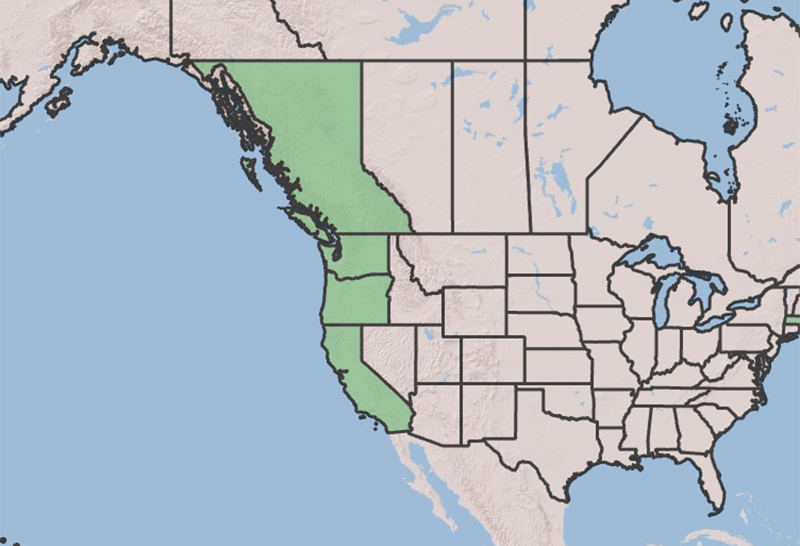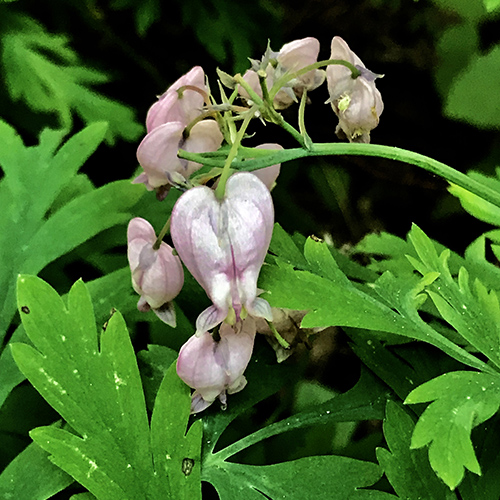Plant of the Week
 Range map of Dicentra formosa. States are colored green where the species may be found.
Range map of Dicentra formosa. States are colored green where the species may be found.
 Close up of the Pacific Bleeding-Heart (Dicentra formosa)
Close up of the Pacific Bleeding-Heart (Dicentra formosa)
 Group of Pacific Bleeding-Hearts (Dicentra formosa).
Group of Pacific Bleeding-Hearts (Dicentra formosa).
 Pacific Bleeding-Heart (Dicentra formosa) in its natural habitat.
Pacific Bleeding-Heart (Dicentra formosa) in its natural habitat.
Pacific Bleeding-Heart (Dicentra formosa)
By Charmaine Delmatier, 2018
Pacific bleeding-heart (Dicentra formosa) is a lush perennial herb rising up to 1.5 feet from stout elongate rhizomes. The six-petaled rose-purple flowers are heart shaped with the outer two petals reflexed resembling spurs. The main stem is leafless (scapose) with 2-30 flowers sitting terminally at the top in drooping clusters. The leaves are all basal and fern-like, with the outer most leaflets without hairs. It is no less than a pure joy to spot these along wooded forest trail. They offer a delicate herbaceous reprieve to a hard-woody forest. They seem delicate but survive some harsh winters, probably due to the subsurface extensive rhizome system. It is native to western North America, specifically to the northwest, blooming between March and June.
According to Kingsley R. Stern in his treatment of Dicentra in Flora of North America, the Fumariaceae family consists of 19 genera and 450 species spaning North America and Eurasia. Dicentra is Greek for "double spurred", referring to the two recurved outer petals that form spurs. More specifically, “dis” means twice and “kentron” means spur. Within the genus Dicentra, petal color ranges from pink to white to brownish with the inner petal margins tinged with purple. However, Pacific bleeding-heart flower color is usually rose-colored. Their habitat is associated with shady moist places in low to mid elevation forests, woodlands, and streambanks. Seeds are black and encased in narrow oblong capsules (pods) only 4-5 mm wide. Their life cycle is interesting. Plants are able to propagate by self-seeding. But during the summer months; they will often become dormant post flowering, and might emerge again in autumn.
A related species in the same genera is steer’s head (Dicentra uniflora), which is often not much taller than an inch and the single flowering head barely exceeds its leaves. The flowers are triangular-shaped resembling a steer’s head. Elevations start at 4,900 ft. and rarely reach as high as 10,000 ft. Related to steer’s head is short-horned steer’s head (Dicentra pauciflora), also with recurved outside petals, but these start their recurve farther down the flowering head, hence the common name. Short-horned steer’s head is restricted to California and Oregon, and often flowers later in the summer.
Historical and current-day medicinal remedies in the fumitory family include skin disorder aids for acne and eczema. Several French and German physicians prefer using members of the fumitory family as a blood purifier for the liver. Some of the northwest native people, the Skagit, used the roots to expel worms and chewed raw roots to offset toothaches.

